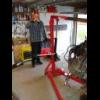
Running 240V To A Shed
#1

Posted 26 May 2013 - 01:09 PM
Question
As This won't be on all the time can I make up a sorta extension lead that I can unplug from the main house when not needed
Or
Do I need to dig a trench and bury it, add a fuse box to the shed ad wire it direct it into the house supply
Thanks
#2

Posted 26 May 2013 - 01:50 PM
No, horrible.
Buy yourself a nice bit of 2.5mm x 3 SWA and bury it. If you are feeling flush and intend to use heavy tools - take a bit of 4mm/6mm instead, stick it on it's own breaker and stick a mini consumer unit in the shed - ELCB is nice as you are out of doors.
To make a nice job of it stick an earth spike at the shed end.
It really won't cost you very much. Not sure where the IEE wiring regs have gone now WRT to working on your own installations.
Edited by Captain Mainwaring, 26 May 2013 - 01:53 PM.
#3

Posted 26 May 2013 - 04:01 PM
.
#4

Posted 26 May 2013 - 04:10 PM
Trac
Also ill just add, you'd do well to leave a bit of string in the tubing just in case you wanted to add some more cables in the future, things line many a phone line for Internet or some speaker cables,
Bit of an over kill for a shed mayby but for the sake of leaving a bit of string in your tubing its proberly worth it
Edited by tractor, 26 May 2013 - 04:13 PM.
#5

Posted 26 May 2013 - 04:39 PM
This is the legal way for you. You either need to be registered as a Part P electrician or to notify building control of your plans otherwise.
N.B. if burying the cable it needs to be circa 750mm down from the surface.
#6

Posted 26 May 2013 - 07:16 PM
#7

Posted 26 May 2013 - 08:23 PM
DO NOT play with an earth spike on this unless you know exactly what you are doing. In fact, ask an electrician to at least look at it for you.
Someone move this thread please.
#8

Posted 26 May 2013 - 08:26 PM
Moved to non mini chat.
#9

Posted 26 May 2013 - 08:35 PM
#10

Posted 26 May 2013 - 08:42 PM
Thanks for the replies, I have a friend who's hubby is a sparks. It looks like its outta my pretty little hands
.
#11

Posted 27 May 2013 - 03:02 AM
http://www.ebay.co.u...D-/221217851163
This is the legal way for you. You either need to be registered as a Part P electrician or to notify building control of your plans otherwise.
N.B. if burying the cable it needs to be circa 750mm down from the surface.
Nah it doesn't - many board supply cables aren't buried as deep as that.
A cable needs to be buried to a depth where it will not be damaged in normal use. 500mm for a bit of SWA is more than enough to be out of reach of normal gardening activities.
It was always on the cards 30 years back that the NICEIC would lobby to get all electrical work under the control of group members....they succeeded.
It won't stop shoddy work, it will just mean it's more expensive and documented.... :-(
#12

Posted 27 May 2013 - 03:19 AM
I would bury some 50mm piping to hopefully keep the water out and if anything goes wrong you won't need to dig the garden back up
Trac
Also ill just add, you'd do well to leave a bit of string in the tubing just in case you wanted to add some more cables in the future, things line many a phone line for Internet or some speaker cables,
Bit of an over kill for a shed mayby but for the sake of leaving a bit of string in your tubing its proberly worth it
Yep, no problem sticking it in a bit of tube - SWA doesn't need protecting, though the tube may be enough to warn someone off if they get close - tile tape is a better alternative though.
Please don't run speaker cables or twisted pair parallel to mains cables - even with SWA you can get all sorts of nasty induced voltages in the low voltage wiring.
DO NOT play with an earth spike on this unless you know exactly what you are doing. In fact, ask an electrician to at least look at it for you.
Someone move this thread please.
DO NOT play with the installation generally unless you know exactly what you are doing. Care to explain what the potential problems are with earth spikes? the main danger with a SWA is that people (so called professional sparks included) tend to install a twin SWA and rely on the wire armouring for the earth bond. You'd be amazed the number of glands, especially the cheapo brass BX glands that are left loose and so the earth continuity is doubtful to say the least - a good way is to be 4 strands of armouring through if you're only going to use a twin, even a good idea if your going to use a 3 core.
An earth spike is a sensible precaution for a remote submain fed by a buried cable - for an overhead with catenary, then it's a must, especially if the supply is fed by TNS, alias PME system.
Spikes need to be installed deep and wet, otherwise there is a possibility of a potential ground loop being formed in the event of an earth fault condition. Livestock have been killed by this near electricity board installations where the star point of each transformer is earthed on a run to provide a fake neutral, and at some point on the run, the neutral has dropped.
Anything has got to be better than a Black and Decker extension lead cable, but as always, if you don't know, call someone who does.
#13

Posted 27 May 2013 - 09:15 AM
Only that someone doing this as an amateur would be quite likely to get it wrong, and the possible consequences could either be very bad or just incredibly irritating. Potential is exactly the problem, as I suspect you know. If they end up with one end of the cable tied in to the PME and bury a rod at the other end of it without properly isolating them then it would cause all sorts of problems. This would be easy to do by mistake if you buy parts from a DIY shed and follow the instructions to make up a gland at both ends of the cable. The potential at the substation where the PME ground comes from is not going to be similar to the potential at the garden shed, and will be far less dependant on the weather. The house might not even be PME, without knowing the installation and being able to run the numbers it's not something that can be guessed at (neither is the appropriate size of the cable, it might need to be 25mm for all anyone here knows). Yes ideally the shed (or especially a greenhouse or metal shed) will be TT but if it's not far from the house, it's a timber shed, and the calculations hold up for disconnect times the best thing is to extend the protection. In my case my brick outbuildings are very close to the house and it would easily be possible to have hold of something plugged in to both buildings at once, so the ground potential of both must be equal. Also I have extended the smoke alarm circuit into the buildings which is wired back into the main panel and not to the outbuilding panel. So the zone has to be contiguous.
Also, as said above don't put TV, phone or anything else in the same duct as power. If you really want some run a second duct 500mm away from the first. In my case I have SWA cat5 and SWA RG59 running to my outbuildings, along with various SWA small cables carrying things like the doorbell circuit, heating controls and other SELV junk out there. It can all be done with a bit of work. The trench doesn't have to be 750mm, only 450. 750mm is for drinking water. If you don't fancy all the digging and you know what's under the lawn rent a Ditch Witch. Expensive but amazing tools like ground cutting chainsaws, designed specifically to cut a deep but narrow trench quickly. If you do the digging, the spark won't charge you as much! Not all SWA is actually designed or suitable for direct burial so a duct may prove to be necessary rather than just a good choice. And don't confuse SWA with SWB, braid is not armour.
I'm not an electrician or part P but I was once a data wireman at a large engineering headquarters complex and I know what is involved. It is tricky to get right without experience and it is potentially dangerous which is why almost all outside work is under part P now. I used to spend my days dragging 320 pair SWA cable that weighs 1/2 ton per 100m through ducts and under roads and buildings, working with the sparks to get power to our poles and boxes so I do understand this stuff and I know how to calculate it all and assess the risks. But I don't have the ticket to let me do it, so I don't because I quite like my house insurance to be valid and not to be in jail. Part P is taken very seriously now.
#14

Posted 27 May 2013 - 09:15 AM
Nah it doesn't - many board supply cables aren't buried as deep as that.http://www.ebay.co.u...D-/221217851163
This is the legal way for you. You either need to be registered as a Part P electrician or to notify building control of your plans otherwise.
N.B. if burying the cable it needs to be circa 750mm down from the surface.
A cable needs to be buried to a depth where it will not be damaged in normal use. 500mm for a bit of SWA is more than enough to be out of reach of normal gardening activities.
Board cables are not covered by BS7671, the wiring regulations. This install will be. The man in the pub who knows how to wire a socket will always get work, whether it's safe or compliant is a different matter. Internet comments like just put in an earth stake, can actually make the installations very dangerous. None of us know the supply characteristics to the main home, whence the suggestion of using the plug in extension lead in the ebay listings.
It was always on the cards 30 years back that the NICEIC would lobby to get all electrical work under the control of group members....they succeeded.
It won't stop shoddy work, it will just mean it's more expensive and documented.... :-(
#15

Posted 27 May 2013 - 09:53 AM
Nah it doesn't - many board supply cables aren't buried as deep as that.http://www.ebay.co.u...D-/221217851163
This is the legal way for you. You either need to be registered as a Part P electrician or to notify building control of your plans otherwise.
N.B. if burying the cable it needs to be circa 750mm down from the surface.
A cable needs to be buried to a depth where it will not be damaged in normal use. 500mm for a bit of SWA is more than enough to be out of reach of normal gardening activities.
Board cables are not covered by BS7671, the wiring regulations. This install will be. The man in the pub who knows how to wire a socket will always get work, whether it's safe or compliant is a different matter. Internet comments like just put in an earth stake, can actually make the installations very dangerous. None of us know the supply characteristics to the main home, whence the suggestion of using the plug in extension lead in the ebay listings.
It was always on the cards 30 years back that the NICEIC would lobby to get all electrical work under the control of group members....they succeeded.
It won't stop shoddy work, it will just mean it's more expensive and documented.... :-(
NICEIC was dedicated years ago to ensuring sheradized screws were used in backboxes, so long as you followed up simple rules like that, your were in the club. I have seen and refused to issue a safety cert for some shoddy installations by NICEIC members. I have seen plenty of sparks who were never interested in registration doing better quality work. Got that off me chest.
The comment regarding board cables was as a reference - and whilst many older cables are steel tape armoured pitch paper cables - newer cables may be concentric PME types, with no armouring. I'll be happy for you to put me right, but i'm pretty sure the regs still state "at a depth not likely to be damaged in normal use" - with this in mind, below the depth of a normal garden fork would be in order, but to be reasonably safe without going wild, the 500mm is more than enough.
Please take the trouble to read my post - I didn't say just throw in a spike as a replacement for the earth - I said it was a sensible addition to the bonding provided by the supply cable - if you'd care to detail under what circumstances an additional earth spike in addition to the earthing provided by the supply cable would be, then I'd be interested to hear them. It's not just "an Internet comment", as an engineer, I'm prepared to justify it. A PME installation will have local earthing holding the neutral down, and overhead will have the star point of the secondary tied down to earth, and in the case of a single phase supply the neutral in times gone past would have had catcher hoops that ensured the phase wire shorted to neutral if for any reason the neutral dropped, again to stop the neutral floating and potentially pulling up the earths in the house.
Sounds like you're a sparks - have you ever seen any incoming heads and cut-outs where the lead sheath of the incomer was cross bonded to neutral? That would be where the cable to the cast iron joint in the road was short, and the wood ferules in the box dried out in the summer and the earth started floating.
In pretty much all domestic supply installations (excluding those where a genset is on standby and has a neutral disconnect) there is no reason why a remote installation will not gain a benefit from it's own earth rod in addition to the earth provided by the main installation.
My career is slightly different to what is was when I qualified - I look after big high pressure steam installations and high voltage power generation, but I did about 5 years house bashing after qualifying MiEE.
1 user(s) are reading this topic
0 members, 1 guests, 0 anonymous users


















